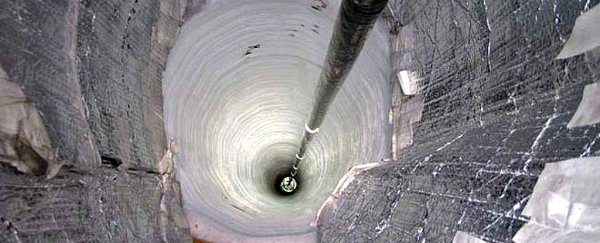In a frozen lab buried deep beneath the South Pole, scientists have spent almost a decade searching for an hypothesised new type of particle, known as the sterile neutrino.
Neutrinos on their own are weird enough - trillions of them are harmlessly flowing through you as you read this sentence, just like tiny ghosts. But sterile neutrinos are even stranger.
While regular neutrinos only interact with matter via weak subatomic force and gravity (which is why we don't feel or see them passing through us), sterile neutrinos are predicted to only interact through gravity - which makes them even harder to spot, and a prime candidate for the identity of dark matter.
But that's assuming they're real. Researchers from the South Pole's IceCube Neutrino Observatory have just announced that after analysing more than 100,000 neutrino events, they're "almost certain" that the sterile neutrino doesn't exist.
"Like Elvis, people see hints of the sterile neutrino everywhere," said one of IceCube's principal investigators, Francis Halzen, from the University of Wisconsin-Madison. "There was this collection of hints, and theorists were convinced it exists."
But let's step back for a second and explain why this hypothetical particle is such a big deal.
There are currently three types or 'flavours' of regular neutrinos that we know definitely exist - muon, electron, and tau.
Being electrically neutral, neutrinos don't interact with matter through the electromagnetic spectrum - things such as light and radio waves - and we can only detect their ghost-like presence in highly sensitive, remote observatories such as IceCube, where the 'background noise' of other particles is filtered out.
You can see the entrance to IceCube in the photo above to get an idea of how isolated it is.
But back in the 1990s, research in the Los Alamos National Laboratory detected weird signals that suggested the existence of a mysterious fourth type of neutrino - one that wouldn't interact with matter at all, except possibly through gravity: hence the name sterile.
Since then, those signals have been seen in other experiments around the world, including most recently in Hong Kong.
If detected directly, the sterile neutrino would be a huge deal, not only because it throws a spanner in the Standard Model of particle physics, but also because it would be a leading contender for dark matter, the mysterious substance that makes up more than 80 percent of the mass in our Universe.
Just like the hypothesised sterile neutrino, we can only see hints of dark matter through gravity, and have never been able to directly observe it.
More than that, the sterile neutrino could actually help scientists figure out why we exist in the first place, by explaining why there's such an imbalance between matter and antimatter.
That imbalance is weird, because the Big Bang event that gave birth to our Universe should have created equal amounts of matter and antimatter, which annihilate each other when they collide. But for some reason, that didn't happen.
Technically speaking, neutrinos shouldn't have mass either, but they do, and scientists suspect that understanding these tiny particles might help explain why there's so much more matter than antimatter around.
"If you throw in a fourth neutrino, it changes everything," said Halzen.
The problem is, the sterile nature of that hypothetical fourth neutrino makes it pretty darn hard to find - if regular neutrinos are ghosts, then trying to find a sterile neutrino is like trying to catch the shadow of a ghost.
But there's one thing the sterile neutrino would interact with that could help us detect it - regular neutrinos. That's because physicists predict that the sterile neutrino would be able to transform into one of the other three types, and vice versa.
So the only way to detect a sterile neutrino directly would be to catch one of the other neutrinos in the act of transforming into it - which is why researchers at IceCube have spent the better part of a decade looking for any evidence of the particle.
If they did manage to spot a traditional neutrino 'disappearing' as it passed through the observatory, it could suggest the presence of the fourth version of the particle.
But two independent analyses - each consisting of a year's worth of data, or about 100,000 neutrino events - has now concluded that there's a 99 percent certainty that the sterile neutrino doesn't exist.
The team has published their results in Physical Review Letters, but you can read them in full for free at ArXiv.
The analyses were performed by looking at atmospheric neutrinos, created when cosmic rays crash into particles in Earth's upper atmosphere.
As those neutrinos rain down from the Northern Hemisphere, Earth acts like a giant filter, sieving out all the other particles, so that only neutrinos will reach the frozen, clear waters of the IceCube observatory, more than a mile (1.6 km) below the South Pole.
The observatory contains 5,160 light-detecting sensors, which are sensitive enough to detect the faint, tell-tale flashes of blue Cherenkov radiation that's released when neutrinos crash into nuclei.
The team was looking at neutrino events that were occurring in the 320 gigaelectronvolt (GeV) to 20 teraelectronvolt (TeV) range - an energy spectrum in which the emergence of sterile neutrinos would produce a very distinctive signature.
But unfortunately, there have been no signs of the hypothetical particle, which suggests it either doesn't exist, or we're looking for the wrong thing. Either way, it means it's time to rethink our idea of the neutrino family, and cross another dark matter candidate off the list.
It's not all bad news though - now that we're finally able to directly detect gravitational waves, it opens up a whole new window on the Universe, one that might finally show us the truth about dark matter, and maybe even those hypothetical sterile neutrino signals.
We can't wait to find out more.
